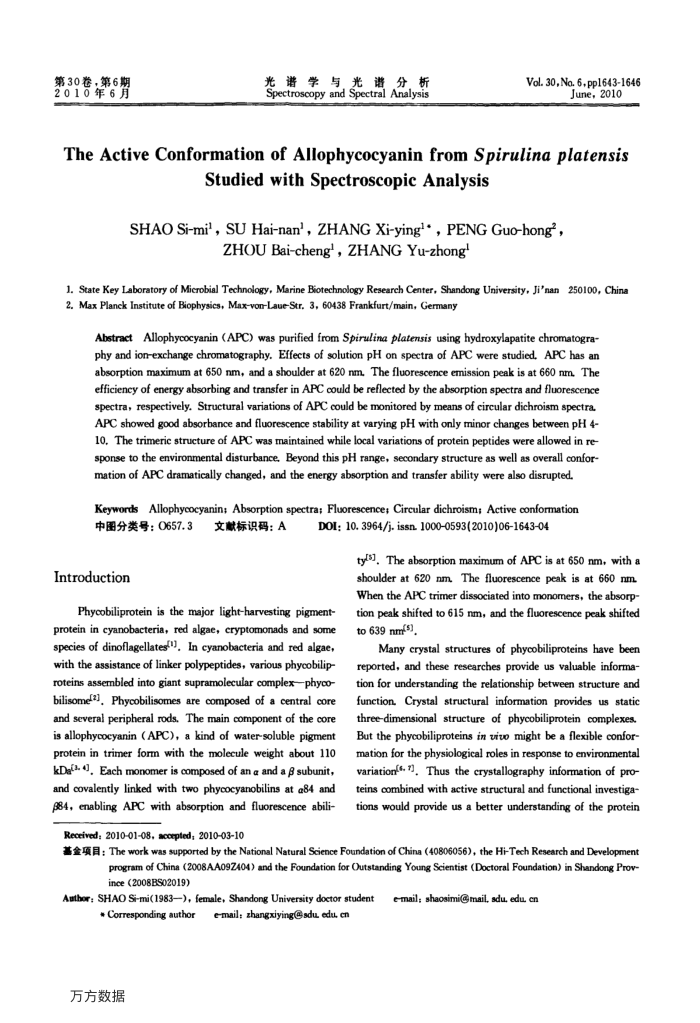光谱学方法对钝顶螺旋藻异藻蓝蛋白活性构象研究
内容简介
 第30卷,第6期 201年6月
第30卷,第6期 201年6月光谱学与光谱分析 Spectroscopy and Spectral Analysis
Vol. 30,No. 6,pp1643-1646
June,2010
TheActiveConformationofAllophycocyaninfromSpirulinaplatensis
Studied with Spectroscopic Analysis
SHAO Si-mi',SU Hai-nan',ZHANG Xi-ying'',PENG Guo-hong,
ZHOU Bai-cheng',ZHANG Yu-zhong
1. State Key Laboratory of Mierobial Technology, Marine Biotechnology Research Center, Shandong University, Ji'nan 250100, China 2. Max Planck Institute of Biophysics, Max-von-Laue-Str, 3, 60438 Frankfurt/main, Germany
Abstract Allophycocyanin (APC) was purified from Spirulina platensis using hydroxylapatite chromatogra phy and ion-exchange chromatography. Effects of solution pH on spectra of APC were studied, APC has an absorption maximum at 650 nm, and a shoulder at 620 nm. The fluorescence emission peak is at 660 nm.The efficiency of energy absorbing and transfer in APC could be reflected by the absorption spectra and fluorescence spectra, respectively. Structural variations of APC could be monitored by means of circular dichroism spectra APC showed good absorbance and fluorescence stability at varying pH with only minor changes between pH 4-10, The trimeric structure of APC was maintained while local variations of protein peptides were allowed in re sponse to the environmental disturbance, Beyond this pH range, secondary structure as well as overall confor
mation of APC dramatically changed, and the energy absorption and transfer ability were also disrupted. KeywordsAllophycocyanin; Absorption spectra; Fluorescence; Circular dichroism; Active conformation
中图分类号:0657.3 Introduction
文献标识码:A
DOI; 10. 3964/j. issn. 1000-0593(2010)06-1643-04
tyls), The absorption maximum of APC is at 650 nm, with a shoulder at 620 nm The fluorescence peak is at 660 nm When the APC trimer dissociated into monomers, the absorp
Phycobiliprotein is the major light-harvesting pigment protein in cyanobacteria, red algae, cryptomonads and some species of dinoflagellatesl"), In cyanobacteria and red algae, with the assistance of linker polypeptides, various phycobilip roteins assembled into giant supramolecular complexphyco bilisomel2), Phycobilisomes are composed of a central core and several peripheral rods,The main component of the core is allophycocyanin (APC), a kind of water-soluble pigment protein in trimer form with the molecule weight about 110 kDaia. 4), Each monomer is composed of an a and a β subunit, and covalently linked with two phycocyanobilins at a84 and β84, enabling APC with absorption and fluorescence abili-
Received; 2010-01-08, acoepted; 2010-03-10
tion peak shifted to 615 nm, and the fluorescence peak shifted to 639 nmfs)
Many crystal structures of phycobiliproteins have been reported, and these researches provide us valuable informa tion for understanding the relationship between structure and function. Crystal struetural information provides us static three-dimensional structure of phycobiliprotein complexes. But the phycobiliproteins in uiwo might be a flexible confor mation for the physiological roles in response to environmental variation[%, 7), Thus the crystallography information of pro teins combined with active structural and functional investiga tions would provide us a better understanding of the protein
基金项: The work was supported by the National Natural Science Foundation of China (40806056), the Hi-Tech Research and Development
program of China (2008AA09ZA04) and the Foundation for Outstanding Young Scientist (Doctoral Foundation) in Shandong Prov ince(2008BS02019)
Author: SHAO Si-mi(1983—), female, Shandong University doctor student
Corresponding author 万方数据
e-mail; zhangxiyingsdu edu, cn
email; shaosimi@mail, sdu,edu cn